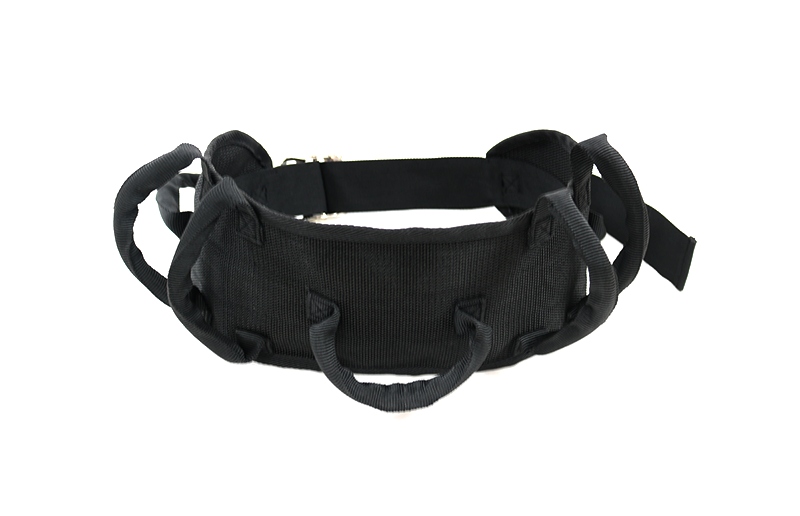Patient handling, while a fundamental part of healthcare, is also a significant source of injuries – for both patients and caregivers. Falls and musculoskeletal injuries (MSIs) are all too common during transfers and repositioning. The good news? Many of these injuries are preventable. Implementing gait belts into your patient handling practices is a proven strategy to dramatically reduce these risks and create a safer environment for everyone. This post will guide you through the “how-to” of implementing gait belts to minimize injury and maximize safety.
1. Understanding the Injury Risks in Patient Handling: A Preventable Problem
Before diving into solutions, it’s crucial to understand the scope of the problem. Patient handling injuries are not inevitable; they are often the result of outdated or inadequate practices:
- Patient Falls: Leading to Significant Harm
- High Incidence Rates: Falls are a leading cause of hospital injuries, particularly among elderly and mobility-impaired patients.
- Severe Consequences: Falls can result in fractures, head trauma, lacerations, and increased length of stay, impacting patient recovery and well-being.
- Fear of Falling: Even non-injury falls can lead to a fear of falling, decreasing patient confidence and mobility.
- Caregiver Back Injuries: An Occupational Epidemic
- Musculoskeletal Disorders (MSDs): Back injuries, shoulder strains, and other MSDs are rampant among healthcare workers due to the physical demands of patient handling.
- Lost Workdays and Costs: Caregiver injuries lead to absenteeism, workers’ compensation claims, and staff turnover, significantly impacting healthcare facility resources and morale.
- Career Impact: MSIs can have long-term consequences for caregivers, potentially shortening careers and impacting quality of life.
2. Gait Belts: Your Injury Prevention Tool – How They Work
Gait belts are not a magic bullet, but they are a cornerstone of evidence-based safe patient handling practices. Here’s how they directly address injury risks:
- For Patient Fall Prevention: Enhancing Stability and Control
- Secure Grip for Caregivers: Gait belts provide a reliable and firm handhold, allowing caregivers to maintain control and stability during transfers and ambulation, minimizing fall risk.
- Improved Patient Balance: The belt offers a point of support, increasing patient confidence and balance, particularly for those with weakness or mobility issues.
- Reduced Unpredictable Movements: Gait belts facilitate smoother, more controlled movements, minimizing jerky actions that can lead to patient instability and falls.
- For Caregiver Back Injury Prevention: Ergonomic Advantages
- Promotes Proper Body Mechanics: Gait belts naturally encourage caregivers to lift with their legs and core, maintaining a straighter back and reducing spinal strain – key principles of ergonomic lifting.
- Reduces Lifting Force: By providing a secure grip, gait belts can amplify caregiver strength, reducing the amount of manual force required to support and move patients.
- Decreases Physical Exertion: Less physical strain translates to reduced fatigue for caregivers, improving their stamina throughout shifts and reducing the cumulative risk of injury over time.
3. Implementing Gait Belts: A Step-by-Step Guide to Success
Simply providing gait belts is not enough. Successful implementation requires a systematic approach:
- Policy and Protocol Development: Make Gait Belts Standard Practice
- Establish a Clear Policy: Create a written policy that mandates gait belt use for all appropriate patient transfers and ambulation activities within your facility.
- Develop Standardized Protocols: Develop clear, step-by-step protocols outlining proper gait belt application, usage techniques, and contraindications.
- Integrate into Patient Handling Guidelines: Ensure gait belt protocols are integrated into your overall safe patient handling and mobility program.
- Comprehensive Staff Training: Knowledge and Hands-On Practice
- Mandatory Training Sessions: Conduct mandatory training sessions for ALL staff involved in patient handling – Nurses, CNAs, Therapists, etc.
- Focus on Proper Techniques: Training must emphasize correct gait belt application, safe transfer techniques (stand pivot, lateral slide, etc.), and ergonomic principles (body mechanics).
- Hands-On Practice and Competency Checks: Incorporate hands-on practice sessions with return demonstrations to ensure staff competency in gait belt use. Regular competency checks are crucial.
- Ongoing Education and Refresher Training: Provide ongoing education and annual refresher training to reinforce proper techniques and address any knowledge gaps or new guidelines.
- Accessibility and Availability: Make Belts Readily Available
- Strategic Placement: Ensure gait belts are readily available and strategically placed in all patient care areas (patient rooms, hallways, therapy gyms, etc.).
- Adequate Supply: Maintain an adequate supply of gait belts in various sizes to accommodate diverse patient populations.
- Easy Access and Storage: Make belts easily accessible – wall-mounted dispensers, within reach in patient rooms – to encourage frequent and convenient use.
- Equipment Maintenance and Inspection: Ensuring Belt Integrity
- Regular Inspections: Establish a routine inspection schedule to check gait belts for wear and tear (fraying, tears, buckle damage).
- Prompt Replacement: Replace damaged or worn belts immediately to ensure safety and effectiveness.
- Cleaning Protocols: Implement and enforce protocols for regular cleaning and disinfection of gait belts to maintain hygiene and prevent cross-contamination.
- Monitoring and Evaluation: Track Your Progress and Outcomes
- Track Fall Rates: Monitor patient fall rates before and after gait belt implementation to assess the impact on fall prevention.
- Monitor Caregiver Injury Data: Track caregiver back injury and MSI rates to evaluate the effectiveness of gait belts in protecting staff.
- Gather Staff Feedback: Solicit staff feedback regularly on gait belt implementation – challenges, successes, and areas for improvement.
- Data-Driven Improvement: Use collected data and feedback to continuously refine your gait belt implementation program and optimize its effectiveness.
4. Conclusion: Invest in Safety – Implement Gait Belts Today
Reducing patient falls and caregiver back injuries is not just a best practice; it’s an ethical imperative. Implementing gait belts into your patient handling practices is a proactive and impactful step towards creating a safer, more sustainable, and more caring healthcare environment. By investing in gait belts, comprehensive training, and consistent implementation, you are investing in the well-being of both your patients and your invaluable healthcare team – ultimately leading to better care and a stronger healthcare facility overall. Start implementing gait belts today and see the positive impact on safety within your organization.

